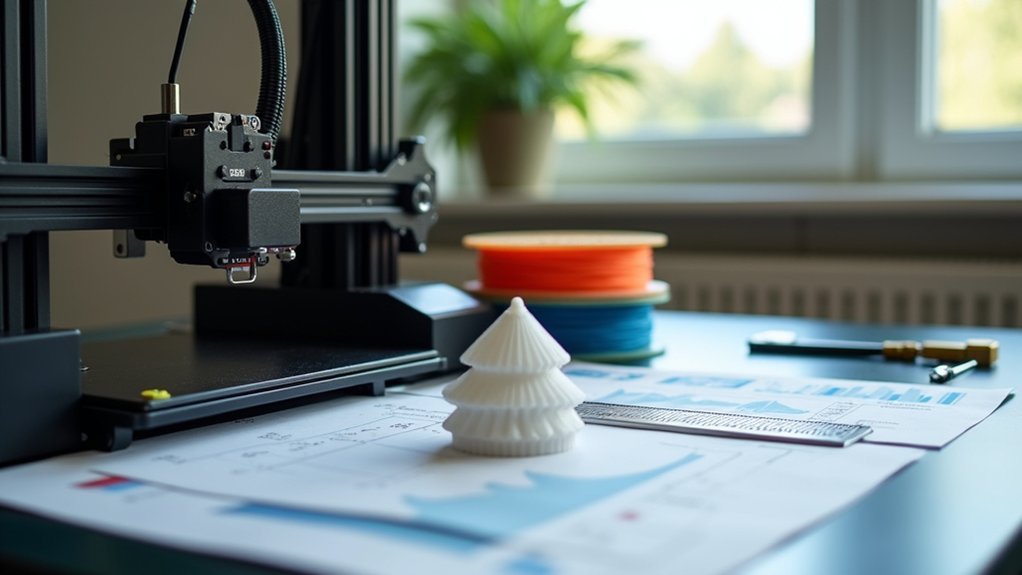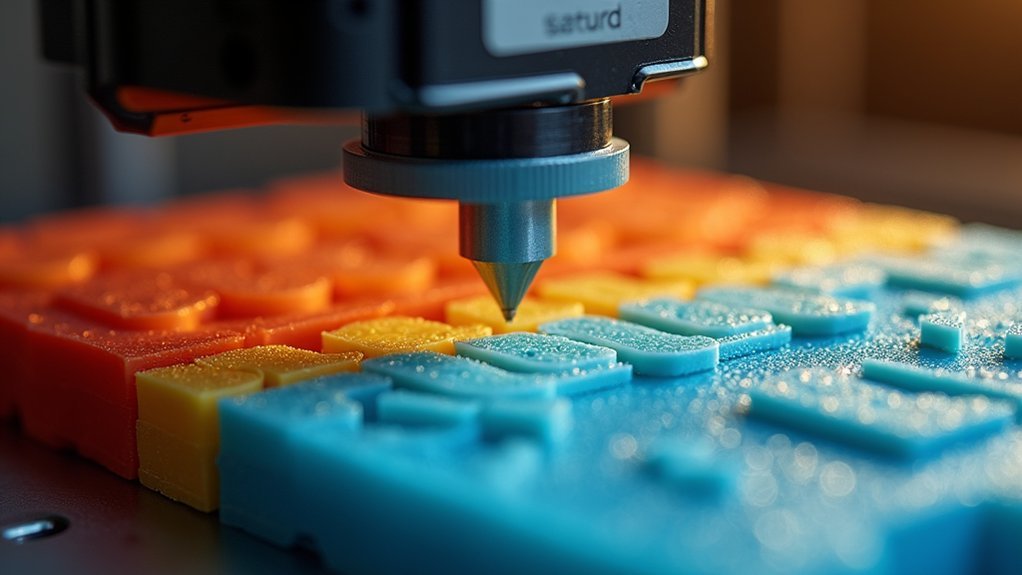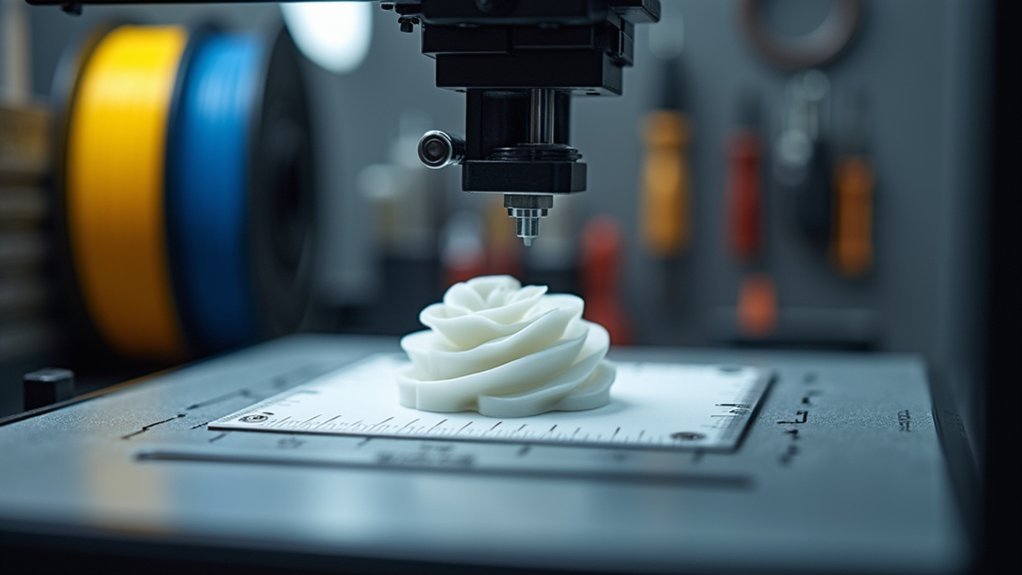You’ll know your retraction distance is excessive when you see filament grinding, blobs on surfaces, or clogs from distances above 5mm. Start by reducing your current settings by 0.5mm intervals while testing with simple STL files. Direct-drive extruders need only 0.5-2.0mm, while Bowden systems require 5-15mm. Balance retraction with speed adjustments between 20-100mm/s and lower your temperature by 5-10 degrees to reduce oozing. These systematic approaches will reveal the best settings for your specific setup.
Identifying Signs of Excessive Retraction Distance

When your 3D printer’s retraction distance is set too high, you’ll notice several telltale problems that can ruin your prints.
The most obvious sign is filament grinding, where your extruder motor chews through the material instead of properly retracting it. This leads to under-extrusion and creates gaps or voids throughout your printed object.
Filament grinding occurs when your extruder motor destroys material during retraction, causing under-extrusion and creating gaps in your prints.
You’ll also spot blobs or zits on your print’s surface when excessive retraction distance pulls back too much filament, causing inconsistent extrusion.
If you’re using retraction distances above 5mm, you’re risking hot end clogs since the filament gets pulled into cooler areas.
Ironically, while trying to prevent stringing, excessive retraction distance can actually worsen it by disrupting your printer’s extrusion consistency.
Understanding the Optimal Retraction Range for Different Extruders
You’ll need different retraction distances depending on your extruder type since the filament path length varies considerably between systems.
Direct-drive extruders work effectively with just 0.5-2.0mm of retraction because the filament travels a short distance from the extruder gear to the nozzle.
Bowden systems require much longer retraction distances, often up to 15mm, because the filament must travel through the entire PTFE tube before any movement affects the nozzle.
Direct-Drive Distance Requirements
Since direct-drive extruders position the motor directly above the hotend, they don’t require the extensive retraction distances that Bowden systems need.
You’ll find that 0.5-2.0mm works perfectly for eliminating stringing without causing problems.
Your direct-drive setup demands precise calibration to avoid common pitfalls:
- Test retraction distance in 1mm increments starting from 0.5mm
- Never exceed 2.0mm to prevent filament grinding and under-extrusion
- Calibrate your extruder before adjusting retraction settings
- Monitor each adjustment’s impact on stringing and print quality
- Make small changes since even minor tweaks greatly affect results
Exceeding the 2.0mm threshold will compromise your print quality through filament grinding and inconsistent extrusion.
You’ll achieve ideal results by staying within this range and fine-tuning incrementally.
Bowden System Considerations
Bowden extruders present a completely different challenge that requires considerably longer retraction distances to combat stringing effectively. You’ll need to work within the 5mm to 15mm range since filament must travel through the entire Bowden tube before retracting at the nozzle.
| Material Type | Starting Distance | Maximum Distance | Increment Steps | Risk Level |
|---|---|---|---|---|
| PLA | 5-7mm | 10mm | 1mm | Low |
| PETG | 6-8mm | 12mm | 1mm | Medium |
| ABS | 7-9mm | 13mm | 1mm | Medium |
| TPU | 3-5mm | 8mm | 0.5mm | High |
| Wood Fill | 6-8mm | 11mm | 1mm | Medium |
Don’t exceed these ranges, as you’ll risk filament grinding and clogs. Monitor your prints carefully after each retraction distance adjustment to find your printer’s sweet spot.
Gradual Reduction Techniques for Testing Retraction Distance

When you’re dealing with excessive retraction distance, you’ll need to systematically test incremental reductions rather than making dramatic changes that could swing from one extreme to another.
Start with your current problematic setting and reduce it by 0.5mm intervals, then run a test print at each step to monitor how stringing and extrusion quality respond.
You’ll want to document each distance setting alongside the corresponding print results so you can identify the sweet spot where stringing disappears without introducing under-extrusion or flow issues.
Incremental Distance Testing Method
Once you’ve identified excessive retraction distance as the culprit behind your print quality issues, you’ll need to systematically reduce the setting through careful incremental testing.
This methodical approach prevents overcorrection and helps you pinpoint the ideal retraction distance for your specific printer and filament combination.
Start with your current retraction distance and work downward in controlled steps:
- Reduce retraction distance by 0.5mm to 1mm increments for precise adjustments
- Keep settings within the safe 0.5mm to 5mm range to prevent jamming
- Maintain consistent travel speeds between 150-250mm/s during testing
- Use simple STL test files to easily identify stringing and oozing
- Monitor each test print closely before making further adjustments
This systematic approach guarantees you’ll find the sweet spot without compromising print quality.
Starting Point Selection Strategy
Before diving into incremental testing, you’ll need to establish the right starting point based on your extruder type and material requirements.
For Bowden extruders, begin with a baseline retraction distance of 4mm, while direct-drive systems should start at 1-2mm. These starting points account for the fundamental differences in filament path length and mechanical response between extruder types.
Consider your material’s characteristics when selecting your initial retraction distance. Flexible filaments typically require shorter distances to prevent jamming, while standard PLA and PETG can handle the baseline recommendations.
Once you’ve established this foundation, you’ll systematically reduce the distance in controlled increments, ensuring each test isolates retraction changes while maintaining consistent temperature and travel speed settings for accurate results.
Progress Monitoring Print Quality
After establishing your baseline retraction distance, you’ll systematically reduce it in 0.5mm increments while carefully monitoring each test print’s quality. This methodical approach prevents overcorrection and helps you identify the sweet spot where stringing disappears without compromising extrusion quality.
Monitor these critical aspects during each test:
- String formation between travel moves and overhangs
- Layer adhesion quality and consistent extrusion flow
- Print surface finish smoothness and dimensional accuracy
- Corner sharpness and detail preservation in fine features
- Overall appearance comparing before and after adjustments
Document your observations after each retraction distance adjustment, noting both improvements and any negative effects.
This systematic testing approach guarantees you’ll find the ideal balance between eliminating stringing while maintaining reliable extrusion performance for your specific printer and filament combination.
Balancing Stringing Prevention With Print Quality

While preventing stringing remains a top priority, you’ll need to find the sweet spot where retraction settings eliminate unwanted filament trails without compromising your print’s overall quality.
Start with retraction distances between 0.5mm and 5mm, making incremental 1mm adjustments during test prints to identify the minimum effective distance. Pair distance adjustments with retraction speed modifications ranging from 1200-6000 mm/min for ideal filament movement.
Consider lowering your print temperature by 5-10 degrees to reduce oozing without affecting extrusion quality. This temperature reduction often allows you to use shorter retraction distances while maintaining string-free prints.
Remember that excessive distances beyond 5mm risk filament grinding and jams, ultimately creating under-extrusion issues that’ll degrade your print quality more than minor stringing ever could.
Adjusting Retraction Speed to Complement Distance Changes
When you increase retraction distance, you’ll need to carefully adjust retraction speed to maintain ideal performance and prevent filament damage.
Finding the right speed-distance balance guarantees your extruder motor maintains proper grip on the filament without causing grinding or separation.
Start with slower speeds around 20 mm/s for longer distances, then use test prints to fine-tune both parameters until you achieve clean retractions without compromising print quality.
Speed-Distance Balance Optimization
Since retraction distance and speed work as interconnected parameters, you’ll need to adjust both settings to achieve ideal stringing control. Your retraction speed should range between 1200-6000 mm/min (20-100 mm/s) to effectively complement distance modifications.
Finding the best balance requires systematic testing:
- Make incremental adjustments – Test each speed-distance combination through actual prints
- Avoid extremes – Too slow causes oozing; too fast risks filament separation
- Consider your extruder type – Bowden setups need faster speeds to compensate for longer distances
- Monitor print quality – Evaluate each change’s impact on both stringing and overall results
- Fine-tune gradually – Small modifications prevent overcorrection
Your goal is minimizing stringing without compromising print quality through careful speed-distance calibration.
Motor Grip Performance
Beyond achieving the right speed-distance combination, your extruder motor’s ability to maintain consistent grip on the filament directly impacts retraction effectiveness. Setting your retraction speed around 20 mm/s enhances motor grip and prevents filament grinding, especially when you’re using longer retraction distances. If you set the speed too fast, the filament may separate, causing under-extrusion during printing.
| Retraction Speed | Motor Performance | Best For |
|---|---|---|
| 20-30 mm/s | Best grip | Flexible materials |
| 40-60 mm/s | Good control | Standard PLA/PETG |
| 80-100 mm/s | Risk grinding | Quick prints only |
You’ll need to test different speeds within the 1200-6000 mm/min range while monitoring print quality to find your material’s ideal balance.
Preventing Filament Grinding From Over-Retraction
Although excessive retraction distances help reduce stringing, they create a more serious problem: filament grinding.
When your extruder motor repeatedly pulls back filament beyond safe limits, it damages the material and causes under-extrusion during prints.
You can prevent this grinding issue through these essential settings:
- Enable “Prevent Filament Grinding” in your slicer to purge material after multiple retractions
- Set maximum retraction count to 10 for soluble filaments and 20 for non-soluble materials
- Use minimum extrusion distance of 1mm to prevent excessive motor pullback
- Keep retraction distance below 7mm to avoid jamming
- Monitor and adjust your retraction settings regularly for peak performance
These adjustments protect your filament while maintaining effective stringing control throughout your printing process.
Temperature Optimization to Reduce Retraction Requirements
While proper retraction settings protect your filament from grinding, fine-tuning your extruder temperature offers a more effective solution by addressing the root cause of stringing.
Temperature fine-tuning reduces filament viscosity, minimizing oozing and excessive retraction requirements. Lower your extruder temperature by 5-10 degrees to decrease filament flow and stringing.
Each material has an ideal temperature range that you’ll need to identify through testing. Conduct temperature tower tests to find the sweet spot for your specific filament type.
Monitor your filament’s behavior at different temperatures—higher temps increase oozing and demand longer retraction distances.
Access your slicer’s “Edit Process Settings” menu to adjust temperature settings precisely. This approach tackles the problem at its source rather than compensating with aggressive retraction that can damage your filament.
Increasing Travel Speed as an Alternative to High Retraction
Another effective method to combat stringing involves increasing your printer’s travel speed rather than cranking up retraction settings. By reducing the time your nozzle spends moving over open spaces, you’ll minimize filament oozing opportunities and achieve cleaner prints.
Here’s why optimizing travel speed works:
- Recommended speeds between 150-250 mm/s considerably decrease non-print move duration
- Faster movements allow shorter retraction distances, preventing filament grinding or jamming
- You’ll achieve better print quality balance without relying solely on high retraction distances
- Less stringing means reduced post-processing cleanup time
- Improved print aesthetics with minimal effort
Experimenting with different travel speeds helps you find the sweet spot for your specific printer and filament combination. This approach creates a more balanced printing strategy.
Material-Specific Retraction Distance Guidelines
Since different materials exhibit unique flow characteristics and thermal properties, you’ll need to adjust retraction distances based on your specific filament type.
For PLA, start with 1-2mm retraction distance, as this material flows smoothly and doesn’t require aggressive settings.
PETG needs longer distances of 3-5mm due to its tendency to string between travel moves.
ABS works well with 2-4mm retraction distance, balancing stringing prevention without causing hotend jams.
Flexible filaments require special attention—keep retraction distance between 0.5-1mm to prevent grinding and maintain consistent extrusion.
These materials compress easily, making excessive retraction counterproductive.
Remember that your extruder type affects these recommendations.
Direct-drive systems typically need shorter distances, while Bowden setups may require up to 15mm.
Always adjust incrementally by 1mm when testing different materials.
Troubleshooting Jams and Blobs Caused by Excessive Retraction
Setting your retraction distance too high creates more problems than it solves. When you exceed 5mm, you’re pulling filament too aggressively, causing jams and surface defects that’ll ruin your prints.
Here’s how to fix excessive retraction distance issues:
- Reduce gradually – Lower your retraction distance by 1mm increments until jamming stops.
- Match your extruder type – Use 0.5-2.0mm for direct-drive, up to 15mm for Bowden setups.
- Adjust retraction speed – Set between 1200-6000 mm/min to prevent filament separation.
- Watch for blobs – High retraction creates zits when filament gets pushed back unevenly.
- Monitor flow consistency – Excessive pulling disrupts extrusion and creates back pressure.
You’ll eliminate most retraction-related problems by finding the sweet spot between preventing stringing and avoiding over-retraction.
Frequently Asked Questions
What Happens if Retraction Distance Is Too High?
You’ll experience filament jams, increased wear, inconsistent extrusion, longer print times, and potentially more stringing. Your extruder can’t effectively re-enter the melt zone, causing gaps and under-extrusion in prints.
How Do You Reduce Stringing Retraction?
You’ll reduce stringing by optimizing retraction distance between 0.5-4mm, adjusting retraction speed to 20-100mm/s, lowering extruder temperature by 5-10 degrees, increasing travel speed to 150-250mm/s, and using effective cooling.
Can Too Much Retraction Cause Clogging?
Yes, you’ll cause clogging if you retract too much. Excessive retraction pulls filament too far back, letting it cool and solidify in the melt zone, creating blockages that prevent proper flow.
What Is the Best Retraction Setting?
You’ll find the best retraction setting depends on your extruder type: use 0.5-2mm for direct-drive, up to 15mm for Bowden systems, with speeds between 20-100mm/s for ideal results.





Leave a Reply